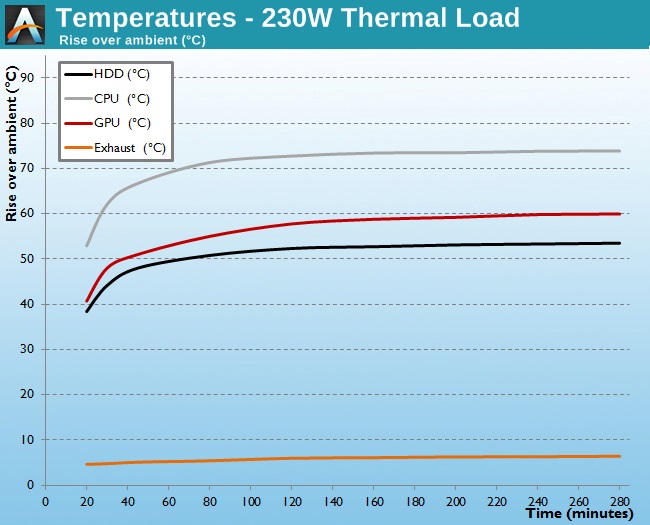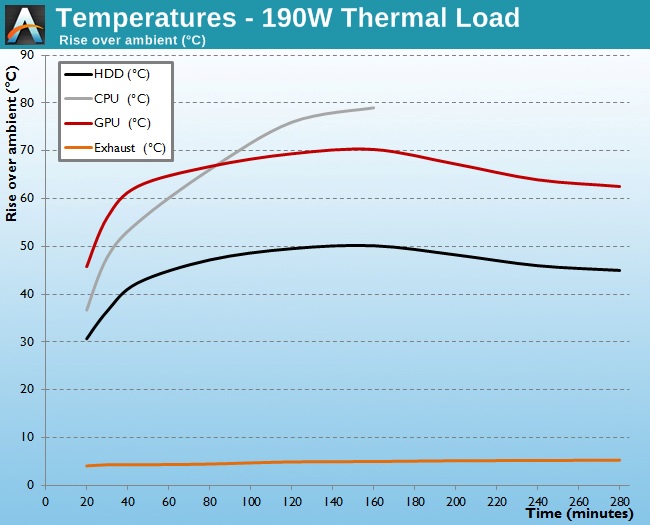SilverStone ML04 & ML05 Slim HTPC Cases Review
by E. Fylladitakis on April 18, 2014 2:30 PM EST- Posted in
- Cases/Cooling/PSUs
- HTPC
- SilverStone
- desktops
Test setup
Professional testing requires the emulation of real-world situations for repeatable results; thus, a perfectly controllable test setup and environment is required, especially for comparable results. Testing the thermal performance of any case with a typical real-world setup technically limits the comparability of the results to this setup alone, as an active system interacts with its environment and the change of a single component alters a myriad of variables. As such, we developed synthetic loads that emulate the thermal output of real systems, with the benefit being that the outputs and loads are passive, steady, and quantifiable. Our thermal testing shows the thermal capabilities of the case alone, as it must cope with the entire thermal load by itself, regardless of the system installed inside it.
Laboratory data loggers are being used to monitor the PT100 sensors and control the safety relays, which are fully accessible via our custom software. Three such loads have been developed. The Micro-ATX version simulates a 180W CPU, 40W VRM, 20W RAM and 1 × 120W GPU card thermal load. The Mini-ITX version simulates a 150W CPU, 30W VRM, 20W RAM and 1 × 120W GPU card thermal load. For low-profile card setups, we are using a 50W dummy GPU card instead. Finally, 2.5" and 3.5" HDD dummy loads have also been created, converting 15W and 30W of electrical power to thermal, respectively. Obviously, the thermal load can be very high and only the best of cases will be able to handle it for more than a few minutes, but we'll be able to quickly differentiate between cases.
Results and discussion
We normally test each setup with the maximum possible load and, for reference, with a lower load as well. For example, the maximum thermal load that our Mini-ITX test setup is capable of over 350W. However, due to the design of both the Milo ML04 and Milo ML05, we cannot really use our full-size GPU load. We should also remind you that neither of these cases has any stock cooling options installed. Even with the low-profile 50W simulated card, both cases could not cope with the stress that our test system was causing for more than a few minutes at maximum power; neither has been designed for handling loads anywhere near such levels. We are thus forced to perform testing only with the minimum possible load, which is:
- 230W for the Milo ML04 (90W CPU, 40W VRM, 20W RAM, 30W HDD and 50W GPU)
- 190W for the Milo ML05 (75W CPU, 30W VRM, 20W RAM, 15W HDD and 50W GPU)
We did not perform any noise-related testing because, well, there was no noise to account for. Neither case has any stock cooling options installed and therefore our instruments would read nothing more than the background noise of the room itself.
The thermal performance of the Silverstone Milo ML04 is mediocre at best, yet very reasonable for a slim desktop chassis with zero stock cooling options. It manages to handle our 230Watt thermal load, though just barely, for several hours, which is more than what we could have hoped for from a case of such small proportions and zero active cooling. We should note that such a thermal load is still about twice as high as the most powerful system most users are likely to install in the Milo ML04 and that a real system will almost certainly have active airflow; we are using such powerful loads because we are stress-testing the designs. The addition of a few exhaust fans would vastly improve these thermal performance figures but we hardly see the point; the Milo ML04 is more than capable to house a very good HTPC and for such systems low noise operation is a far greater priority rather than a few degrees Celsius.
Silverstone Milo ML04B
Unfortunately, the thermal testing of the Milo ML05 was cut a little early, as the tiny case proved unable to handle the 190Watt load for prolonged periods of time. Our safety system decoupled the CPU/VRM load entirely due to overheating; we left the system running for reference but the thermal figures beyond that point have little meaning, as the load has been reduced down to 85W. Still, the tiny case handled a great thermal load for nearly three hours without any activce cooling at all, which is rather impressive. Again, the addition of active cooling would help the thermal performance of the Milo ML05 dramatically but, as with the Milo ML04, we do not believe there is a point in doing so. After all, this is not an enclosure meant to house GTX TITAN or R9 290X GPUs; the thermal load from a typical HTPC Mini-ITX system should not be more than 20-30W, and idle loads will be even lower.
Silverstone Milo ML05B












39 Comments
View All Comments
Voldenuit - Sunday, April 20, 2014 - link
My bad, confused the two model numbers - the ML04 is the bigger one and does indeed have provision for a riser card (although if I understand correctly no riser card is bundled), and any card installed on said riser can only be single slot in width.Also, for some inane reason, the riser is oriented the wrong way and blocks off the CPU cooler, which is almost as bad as not having a riser at all, IMO.
Daniel Egger - Sunday, April 20, 2014 - link
Nowadays the main problem doesn't seem to be getting good low profile cards but cards which only need one slot as even the new Maxwell cards tend to require 2 full profile slots. So even if you have a case that supports a riser card you'll only have a single slot available...I very much gave up on the very small cases and instead opted for a somewhat big Lian Li PC-C50B. There're only a very small number of cases in desktop format that support a dual slot full profile card *and* a 5 1/4" drive...
rogueninja - Sunday, April 20, 2014 - link
Hot damn those are some ugly chassis. Never put meshes out of nowhere. It's either you make the entire panel a mesh, or nothing.billobob - Monday, April 21, 2014 - link
With the advent of the steam box and overall slow but steady advance of controller living room PC gaming, you can't really view HTPCs as exclusively media players anymore. In fact, given the nature of people building their own PCs in the first place, I'd argue its pretty damn common. With the rise of cheap streaming boxes and other appliances the number of people building media-only HTPCs is probably on the downswing.It would be nice to see some real thermal and noise testing as you'd do for a conventional case. A passive low watt test for media only use, and active test with appropriate components (ie midgrade mini-ITX or mid-premium ATX GPUs depending on the case). Sound is even more important because as someone who games with a computer in my living room, ironically the best noise data out there is for huge gaming cases.
MichaelD - Monday, April 21, 2014 - link
I recently built a low-power HTPC in the ML04. This case was exactly what I was looking for. Very plain front panel, same size as most HT-type equipment, locking front door and the lockable power button was icing on the cake. This case is definitely a PITA to build in, but I knew that from reading the online reviews. I run the OS off an SSD. Media is either streamed from the net or from my NAS. Stock Intel HSF and two silent 80mm case fans and you cannot hear it from more than 3 feet away. IMO, this is the perfect HTPC case for people that actually want a case as opposed to a tiny NUC-type device that you mount with Velcro to the back of the TV.plonk420 - Tuesday, April 22, 2014 - link
nice @ having a dimmable LED. i have the ML03 and i had to tape some thick paper over my HDD LED as it would flicker off the wall in front of the HTPC (which was right below as well as on my DLP projector's screen)another ghetto rigging i did was i replaced the 40 or 60mm fan on my E-350's heatsink with a twist-tied 120mm Arctic Cooling F12 Pro (PWM) to blow down onto the heatsink. it's ridiculously quiet.
wheat_thins - Monday, April 28, 2014 - link
I have been out of the HTPC loop for awhile. What's the opinion on front end these days? Is XBMC still being updated? Are people doing windows media center? I just want a box that I can easily control with just a remote or mini keyboard + trackpad that can stream movies, pictures, mp3's from my local NAS. Native Netflix, Pandora, Youtube, Weather apps would be a bonus so I would not need a keyboard.sirizak - Tuesday, April 29, 2014 - link
Xbmc is still going strong, I've recently built 2 HTPC's in the ML05, running Xbmcbuntu Linux. Not sure about Netflix but I believe there is an addon for Pandora, definitely has YouTube and weather support. PVR support has come a very long way as well now. Using an flirc adapter and a harmony remote. Very easy to use and versatile.sirizak - Tuesday, April 29, 2014 - link
Recently built a Htpc in the ML05 to replace a tivo which has shut down in Australia.MSI H87I, Pentium G3220, harmony remote via flirc adapter, Sony playtv tuner, running Xbmcbuntu. Working very well, and much more versatile than the tivo.
The ML05 is not terribly pretty but it's small size means it doesn't attract attention which was the real goal.